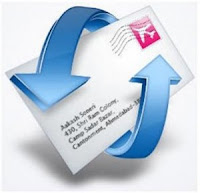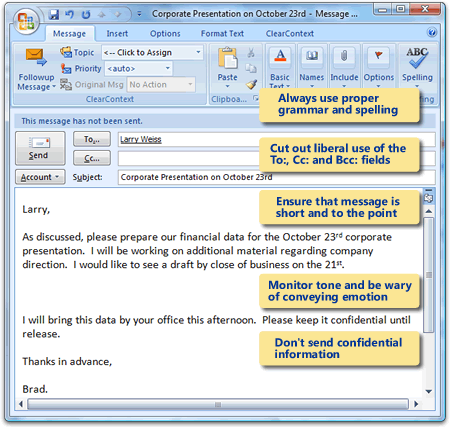 Committing a major email faux pas is a lot easier than you think. One minute you’re forwarding a seemingly-innocent email to friends and family, only to find out that you’ve unwittingly offended half of your contact list the next. Many of us think of cyberspace as a casual arena where anything can be said and done for laughs. However, as email becomes an increasingly popular form of communication, it’s important to choose your words wisely—and to be conscious about who you send them to. So before you dash off a hasty message, make sure you avoid these eight all-too-common email blunders.
Committing a major email faux pas is a lot easier than you think. One minute you’re forwarding a seemingly-innocent email to friends and family, only to find out that you’ve unwittingly offended half of your contact list the next. Many of us think of cyberspace as a casual arena where anything can be said and done for laughs. However, as email becomes an increasingly popular form of communication, it’s important to choose your words wisely—and to be conscious about who you send them to. So before you dash off a hasty message, make sure you avoid these eight all-too-common email blunders.1. Don’t Abuse the Reply All
“Reply all is like salt—it should be used only when needed, and with caution,” says etiquette expert Jodi Smith. Only use reply all when everyone on the list of addresses requires your response. Most of the time, it is sufficient to only reply to the person who sent you the email. Of course, every email program displays things differently, so sometimes you don’t even realize you’ve replied all until your cubicle neighbor gently informs you that the entire company just received your snippy response about the new vacation-approval policy. When responding to an email, it’s always a good idea to take a moment and confirm that it’s only headed to your intended recipient.
“Reply all is like salt—it should be used only when needed, and with caution,” says etiquette expert Jodi Smith. Only use reply all when everyone on the list of addresses requires your response. Most of the time, it is sufficient to only reply to the person who sent you the email. Of course, every email program displays things differently, so sometimes you don’t even realize you’ve replied all until your cubicle neighbor gently informs you that the entire company just received your snippy response about the new vacation-approval policy. When responding to an email, it’s always a good idea to take a moment and confirm that it’s only headed to your intended recipient.
 2. Be Careful with the Bcc
2. Be Careful with the BccThe “Bcc:” option allows you to “blind carbon copy” someone on an email without any of the other recipients knowing. It’s useful in certain instances, like when you’re sending a message to a large mailing list and wish to keep peoples’ email addresses private, or when you are requesting information from a group and want to make sure replies only come to you. But Bcc’ing can also backfire, big time. Say you email that snippy woman from the PTA and Bcc your best friend so she can take a peep; if the best friend hits reply all, PTA lady will get her response, and you’ll be busted. The best Bcc rule of thumb: Never use it for sneaky reasons!
3. Avoid Casual Cursing
Its fine to %*@* this or $&@# that, as long as you’re emailing a friend or close coworker, right? Wrong. “You may think you’re venting to someone close to you, but if the recipient forwards that email, you no longer have any control over what you said,” Smith explains. And you know how things can get forwarded again, and again, and again. “Email is a permanent document that can always be retrieved and used against you,” warns etiquette consultant Jacqueline Whitmore. For people who aren’t familiar with your sense of humor, cursing can make you look ignorant or extremely frustrated, so keep that in mind next time your want to let off a little steam via email.
Its fine to %*@* this or $&@# that, as long as you’re emailing a friend or close coworker, right? Wrong. “You may think you’re venting to someone close to you, but if the recipient forwards that email, you no longer have any control over what you said,” Smith explains. And you know how things can get forwarded again, and again, and again. “Email is a permanent document that can always be retrieved and used against you,” warns etiquette consultant Jacqueline Whitmore. For people who aren’t familiar with your sense of humor, cursing can make you look ignorant or extremely frustrated, so keep that in mind next time your want to let off a little steam via email.
4. Don’t Be Lazy About Grammar
It’s a slippery slope: First, you stop capitalizing the first letter of sentences. Then you stop forming complete sentences. Next thing you know, even backspacing to fix a blatant spelling error feels way too strenuous—never mind double-checking your grammar usage. When even your boss’s emails lack grammatical correctness, it’s easy to relax your standards. However, keeping your grammar bar high makes you stand out—in a good way. “In this economy, you need to be as polished and professional as possible,” Smith says. “Especially in business, your competence is judged by observable behaviors. Poor grammar, punctuation and spelling can signal incompetence.”
It’s a slippery slope: First, you stop capitalizing the first letter of sentences. Then you stop forming complete sentences. Next thing you know, even backspacing to fix a blatant spelling error feels way too strenuous—never mind double-checking your grammar usage. When even your boss’s emails lack grammatical correctness, it’s easy to relax your standards. However, keeping your grammar bar high makes you stand out—in a good way. “In this economy, you need to be as polished and professional as possible,” Smith says. “Especially in business, your competence is judged by observable behaviors. Poor grammar, punctuation and spelling can signal incompetence.”
5. Always Respond
After plowing through the contents of your inbox on a busy workday, it’s easy to forget to circle back and respond to messages. Take the time to reply as you go (even just to say you got the email), and you’ll avoid that constant, nagging feeling that you’ve forgotten something. In general, aim to reply to emails within 24 hours. However, “you don’t have to respond to every email,” Whitmore says. “For example, if someone thanks you in an email, you don’t have to email them to say thank you for the thank you. Use your best judgment.”
After plowing through the contents of your inbox on a busy workday, it’s easy to forget to circle back and respond to messages. Take the time to reply as you go (even just to say you got the email), and you’ll avoid that constant, nagging feeling that you’ve forgotten something. In general, aim to reply to emails within 24 hours. However, “you don’t have to respond to every email,” Whitmore says. “For example, if someone thanks you in an email, you don’t have to email them to say thank you for the thank you. Use your best judgment.”
6. Watch Out for Uppercase Overkill
In email land, writing in all capital letters means YOU ARE YELLING AT SOMEONE. Unless that’s what you’re going for, better unclick that caps lock button. “To emphasize one word, place *asterisks* around it instead,” Whitmore suggests.
In email land, writing in all capital letters means YOU ARE YELLING AT SOMEONE. Unless that’s what you’re going for, better unclick that caps lock button. “To emphasize one word, place *asterisks* around it instead,” Whitmore suggests.
7. Be Wary of Attachment Overload
The 11 photos of your new puppy you sent to your best friend won’t seem as cute when they’re causing her email to take 11 minutes to load—or crashing her computer completely. “Always ask permission before sending large attachments,” Whitmore advises. When in doubt, save documents in a PDF format, which will help prevent download problems.
The 11 photos of your new puppy you sent to your best friend won’t seem as cute when they’re causing her email to take 11 minutes to load—or crashing her computer completely. “Always ask permission before sending large attachments,” Whitmore advises. When in doubt, save documents in a PDF format, which will help prevent download problems.
8. No Unnecessary Use of Cuteness
If you enjoy using emoticons (smileys, the “surprised” face) and acronyms (LOL, BTW, TTYL), at least banish them from your professional correspondence. They can be distracting, confusing, or worse, make you seem more like a high schooler than a trusted colleague. One thing you should be including in all your business emails: a signature that provides your full name, title, work address and phone number.
If you enjoy using emoticons (smileys, the “surprised” face) and acronyms (LOL, BTW, TTYL), at least banish them from your professional correspondence. They can be distracting, confusing, or worse, make you seem more like a high schooler than a trusted colleague. One thing you should be including in all your business emails: a signature that provides your full name, title, work address and phone number.
Source : Click Here
Комментариев нет:
Отправить комментарий